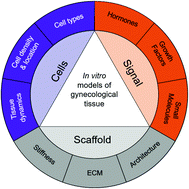Biomaterial strategies to replicate gynecological tissue
Abstract
Women's health is an important and understudied area of research. The current standard of care for many gynecological diseases such as cancer or autoimmune-linked disorders such as endometriosis is surgery; however, the underlying mechanisms of action of many gynecological diseases are poorly understood. The field of tissue engineering has the potential to transform the field of women's health by developing in vitro models of healthy and diseased tissue that could be used to identify novel treatment strategies as well as gain a better understanding of complex signaling dynamics. Identification of the appropriate biomaterials, cell types, and stimuli (the tissue engineering triad) needed to build these in vitro models can be gleaned by interrogating the underlying extracellular matrix, cell organization, and soluble factors present in the tissue. In this review, we provide a general overview of the biology and components of the major tissues that make up the female reproductive system (ovaries, fallopian tubes, the uterus, and cervix) as well as a comprehensive survey of the different biomaterials that have been chosen to build in vitro models of these tissues. Furthermore, for each tissue, we recommend guiding principles in the design of in vitro models and discuss their potential to be used in drug screening and mechanistic studies.

- This article is part of the themed collection: Biomaterials Science Emerging Investigators 2021


 Please wait while we load your content...
Please wait while we load your content...